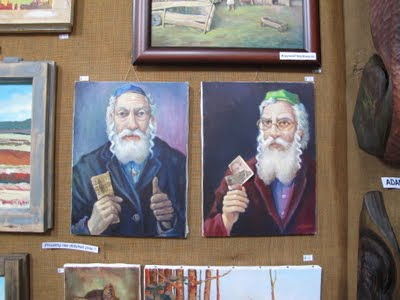 |
| Former Synagogue in Lesko. Photo (c) Ruth Ellen Gruber |
By Ruth Ellen Gruber
The last time I had been in Lesko was in 2006, when I was updating my book Jewish Heritage Travel -- but also attending the annual biker and country music festival held there, "Moto Country Piknik." It was a wild night full of black leather-clad beer-drinkers, heavy metal chrome, and Polish country acts, most of whose names I didn't get.
 |
| Lesko Moto Country festival, 2006. Photo (c) Ruth Ellen Gruber |
Five years later, on the Jewish heritage front, I found little changed...
The imposing synagogue, just off the main market square, dates from the mid 17th century. It is the only one of five prayer houses to survive World War II. It was devastated during the war and rebuilt in the 1960s -- the reconstruction added baroque gables (which a booklet on sale at the synagogue said had been removed in the 19th century). That on the front facade frames the depiction of the Ten Commandments. The reconstruction also extended the height of the tower so that it now extends above the roof level.
All in all, I find it a very beautiful and impressive building -- and, importantly, there has long been separate signpost outside identifying it as a former synagogue and describing the history: before World War II, nearly two-thirds of the town population was Jewish. In the entry hall there are several plaques listing the names of hundreds of Lesko Jews killed at the Belzec death camp in 1942.
 |
| Memorial to Lesko Jews at Belzec. Photo (c) Ruth Ellen Gruber |
The synagogue is now used as a gallery displaing and selling local arts and crafts. Five years ago I bought there a wonderful naive carving of the late Pope John Paul II, wearing red shoes and with his head surrounded by angels.
 |
| Inside the synagogue gallery. Photo (c) Ruth Ellen Gruber |
Each time I've visited the gallery, I've found a refreshing lack of kitschy carved Jewish figures and paintings on sale -- such as those so prevalent in Krakow and Warsaw... but one of the local artists still did utilize the "Jew and money" stereotype in a rather outrageous manner! That's real money clutched in their hands!
 |
| Photo (c) Ruth Ellen Gruber |
The Jewish cemetery in Lesko, founded in the 16th century, is one of the oldest and most historically important in Poland. It is vast, and rises up a steep hill, just down the road from the synagogue. The oldest stones are at the bottom, by the entrance -- massive slabs with vividly carved epitaphs but no other decoration. Here is where the tour groups stop -- a Polish tour group was visiting this time when I entered.
 |
| Photo (c) Ruth Ellen Gruber |
The higher you go the more, and more recent, and more vividly carved stones there are. But also -- at least in early summer -- the more overgrown and untended do you find them..... it is a real wasteland; I have to say, I felt both glad to see people (like the tour group) visiting, but rather lonely and depressed that so much of the cemetery was a jungle. And this comes from someone who has seen endless overgrown Jewish cemeteries in Eastern Europe! I think the contrast of the "known" and "unknown" -- the "remembered" and the "forgotten" -- just got to me.
 |
| Photo (c) Ruth Ellen Gruber |
I can't put it any better than a post I have linked to before -- a description of the Lesko cemetery on the riowang.blogspot.com site.





No comments:
Post a Comment